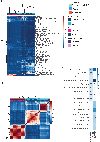Deconvolution of Human Urine across the Transcriptome and Metabolome
- PMID: 39383112
- PMCID: PMC11927302
- DOI: 10.1093/clinchem/hvae137
Deconvolution of Human Urine across the Transcriptome and Metabolome
Abstract
Background: Early detection of the cell type changes underlying several genitourinary tract diseases largely remains an unmet clinical need, where existing assays, if available, lack the cellular resolution afforded by an invasive biopsy. While messenger RNA in urine could reflect the dynamic signal that facilitates early detection, current measurements primarily detect single genes and thus do not reflect the entire transcriptome and the underlying contributions of cell type-specific RNA.
Methods: We isolated and sequenced the cell-free RNA (cfRNA) and sediment RNA from human urine samples (n = 6 healthy controls and n = 12 kidney stone patients) and measured the urine metabolome. We analyzed the resulting urine transcriptomes by deconvolving the noninvasively measurable cell type contributions and comparing to plasma cfRNA and the measured urine metabolome.
Results: Urine transcriptome cell type deconvolution primarily yielded relative fractional contributions from genitourinary tract cell types in addition to cell types from high-turnover solid tissues beyond the genitourinary tract. Comparison to plasma cfRNA yielded enrichment of metabolic pathways and a distinct cell type spectrum. Integration of urine transcriptomic and metabolomic measurements yielded enrichment for metabolic pathways involved in amino acid metabolism and overlapped with metabolic subsystems associated with proximal tubule function.
Conclusions: Noninvasive whole transcriptome measurements of human urine cfRNA and sediment RNA reflects signal from hard-to-biopsy tissues exhibiting low representation in blood plasma cfRNA liquid biopsy at cell type resolution and are enriched in signal from metabolic pathways measurable in the urine metabolome.
© Association for Diagnostics & Laboratory Medicine 2024.
Conflict of interest statement
Figures




Update of
-
Multiomics characterization of cell type repertoires for urine liquid biopsies.bioRxiv [Preprint]. 2023 Oct 23:2023.10.20.563226. doi: 10.1101/2023.10.20.563226. bioRxiv. 2023. Update in: Clin Chem. 2024 Nov 4;70(11):1344-1354. doi: 10.1093/clinchem/hvae137. PMID: 37961398 Free PMC article. Updated. Preprint.
Comment in
-
Clinical Perspective on the Use of Urine as a Tissue Surrogate in the Diagnosis of Genitourinary Diseases.Clin Chem. 2024 Nov 4;70(11):1303-1304. doi: 10.1093/clinchem/hvae145. Clin Chem. 2024. PMID: 39329338 No abstract available.
References
-
- Barkan GA, Wojcik EM. Genitourinary cytopathology (kidney and urinary tract). Cancer Treat Res 2014;160:149–83. - PubMed
-
- Locatelli F, Vecchio LD, Pozzoni P. The importance of early detection of chronic kidney disease. Nephrol Dial Transplant 2002;17(Suppl 11):2–7. - PubMed
-
- Loeb S, Vellekoop A, Ahmed HU, Catto J, Emberton M, Nam R, et al. Systematic review of complications of prostate biopsy. Eur Urol 2013;64:876–92. - PubMed
MeSH terms
Substances
Grants and funding
LinkOut - more resources
Full Text Sources

